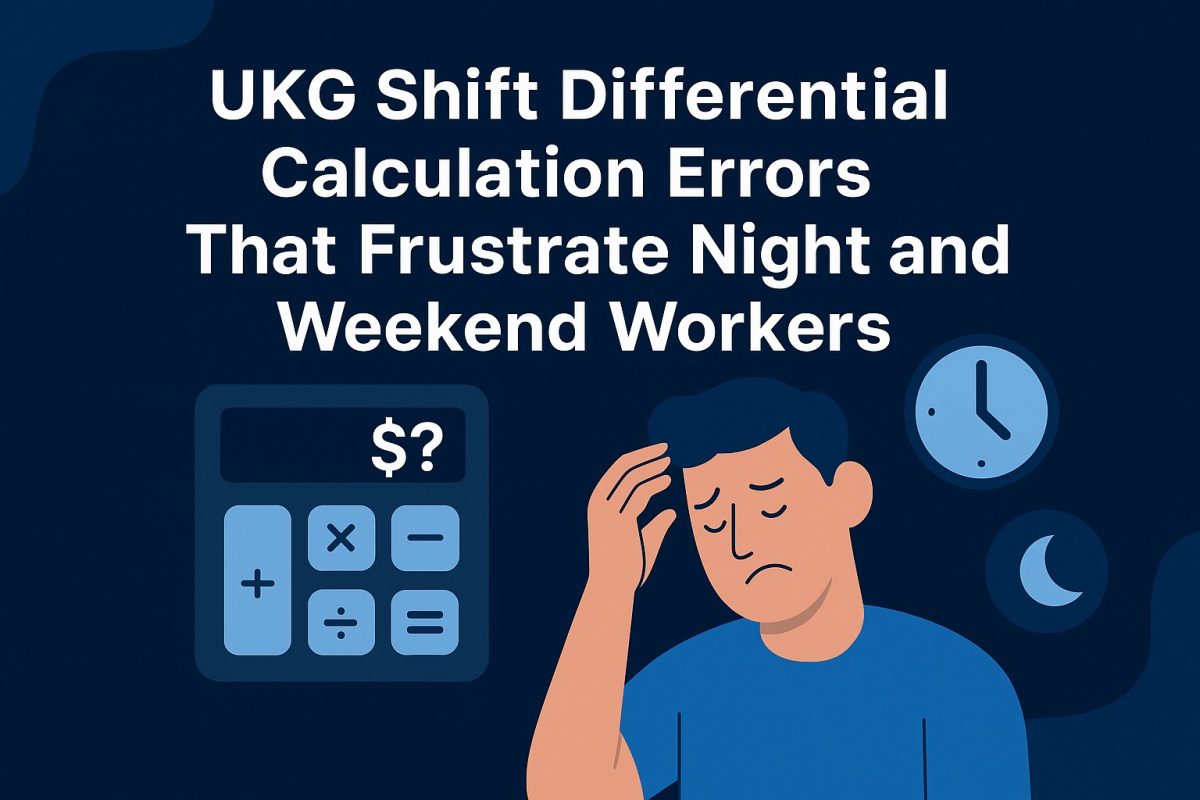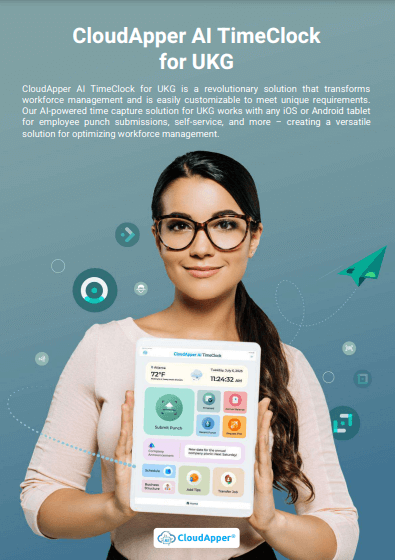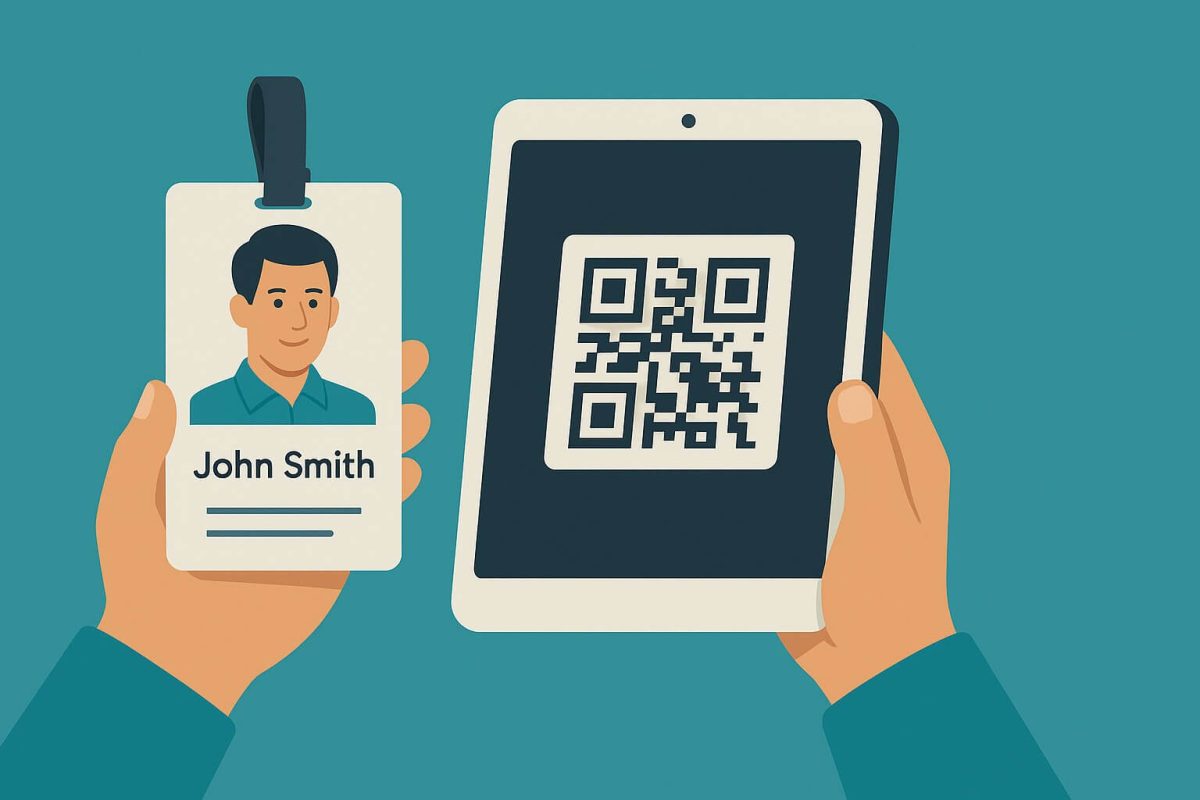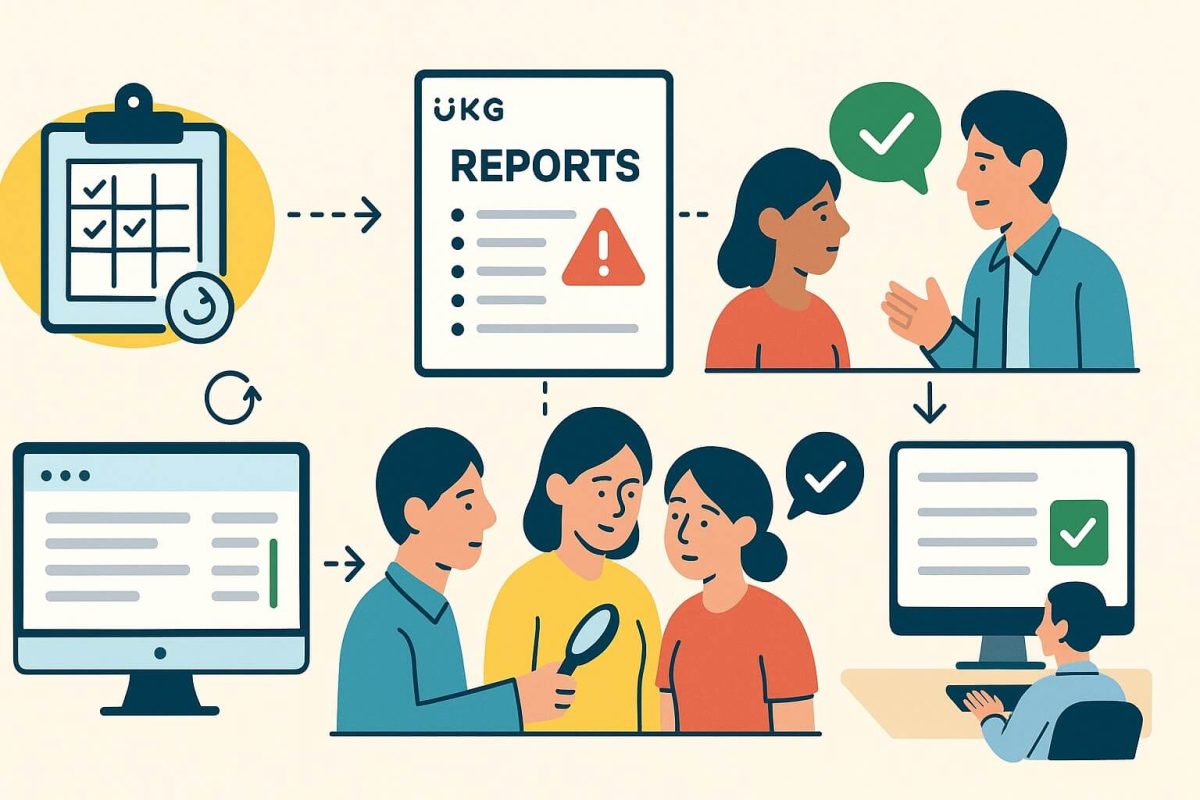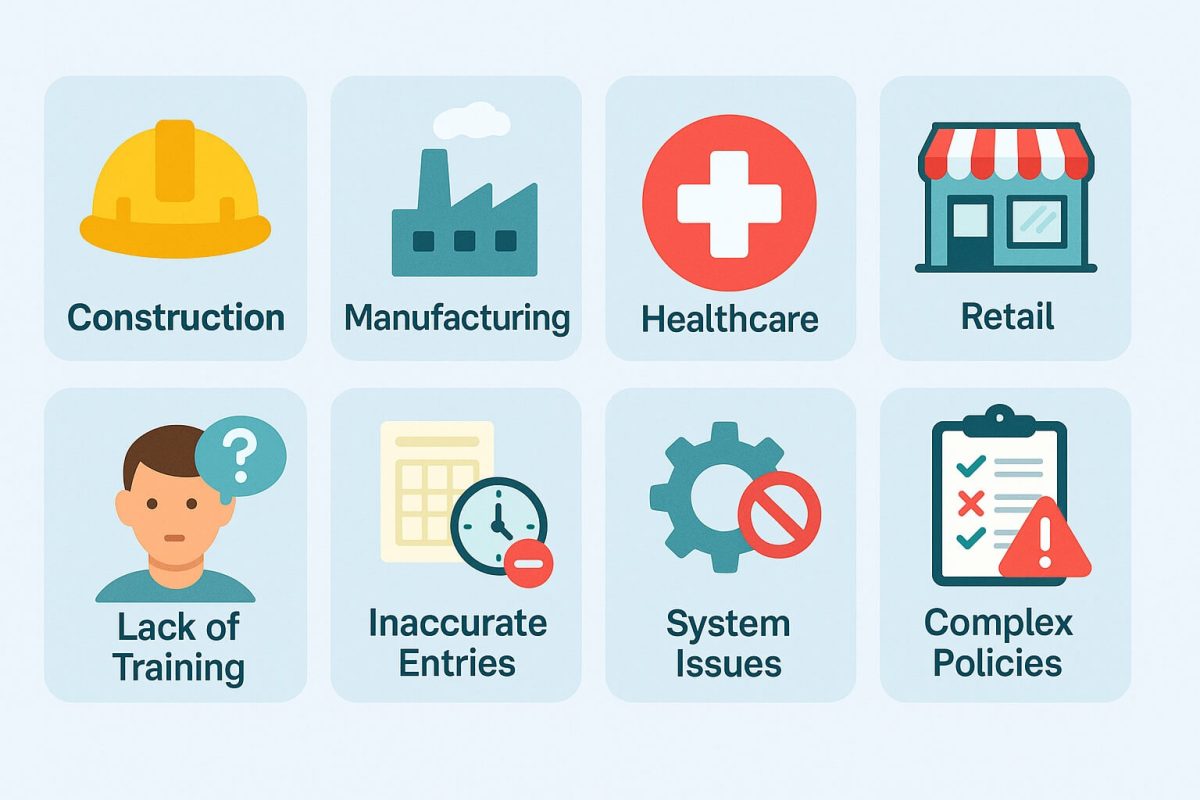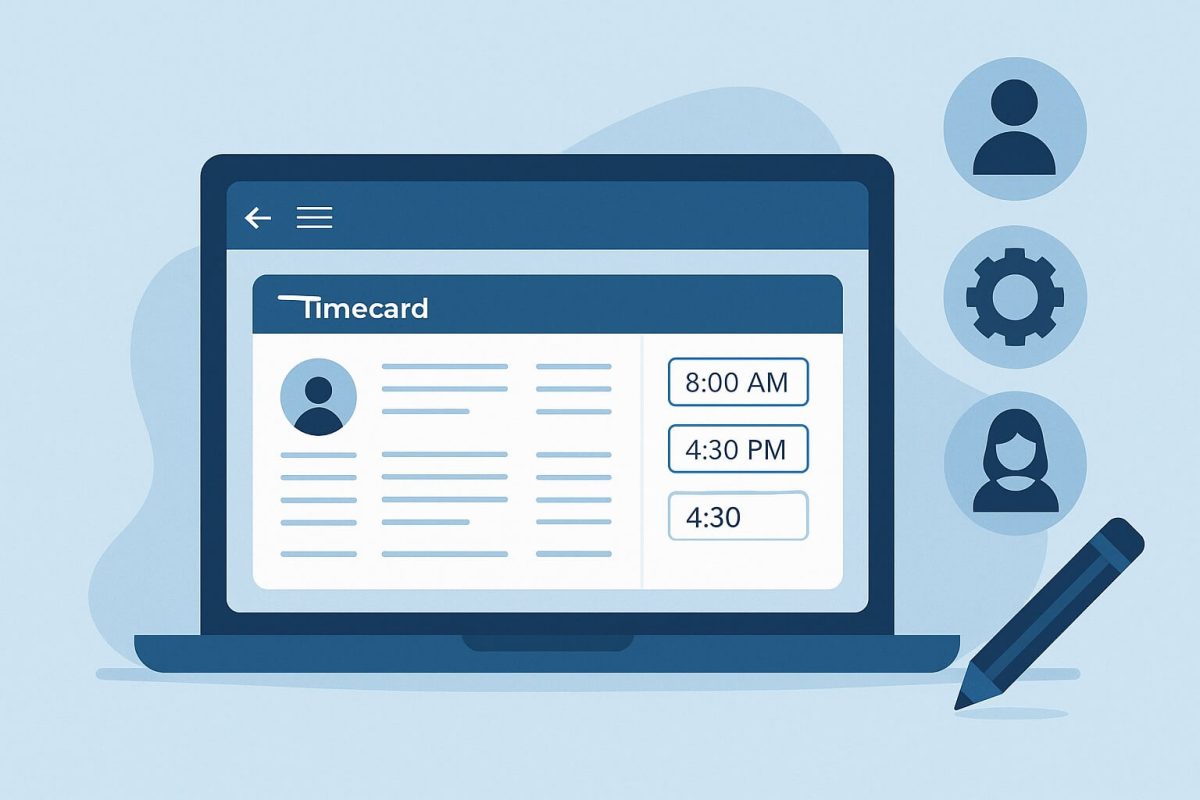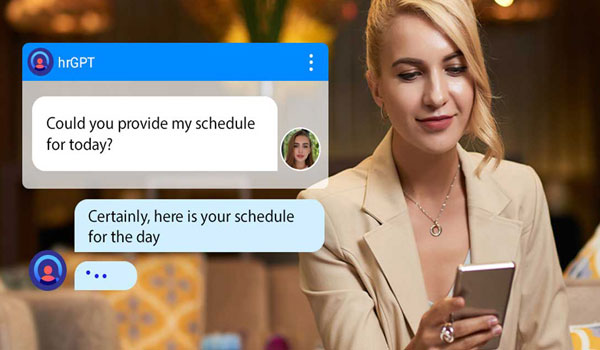Shift differential errors in UKG payroll silently drain budgets and frustrate employees, costing organizations up to $156,000 annually. Inaccurate time capture, boundary miscalculations, and overtime miscalculations fuel these losses. CloudApper AI TimeClock delivers exact-minute tracking, AI-driven validation, and seamless UKG integration to eliminate errors and restore payroll accuracy.
Table of Contents
Night shift nurses, weekend manufacturing workers, and 24/7 call center agents are losing thousands in unpaid premiums due to UKG shift differential calculation errors. This comprehensive analysis reveals how imprecise time capture creates $156,000 in annual losses while a simple AI-powered solution eliminates 97% of differential errors instantly.
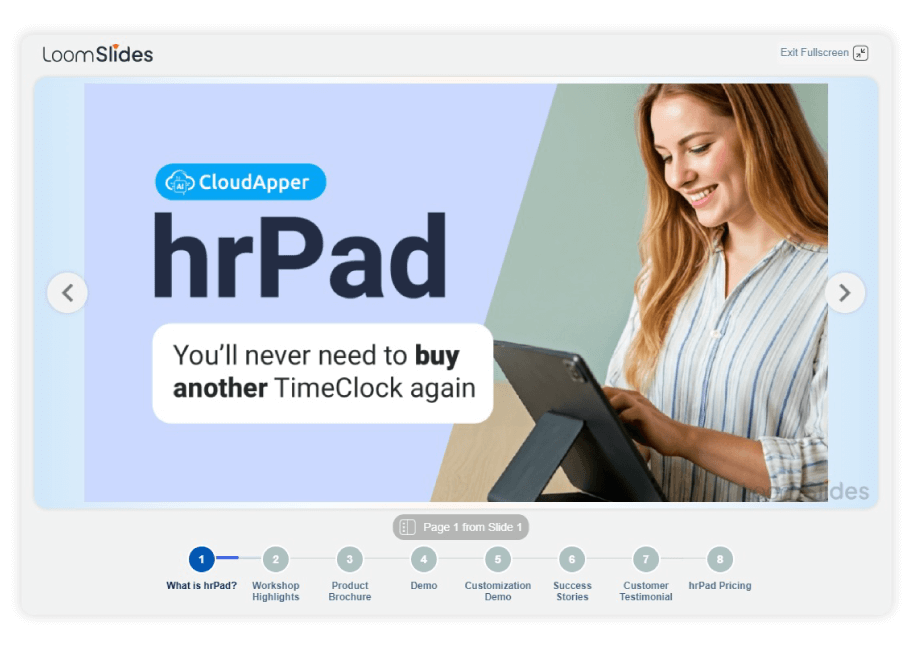
For more information on CloudApper AI TimeClock for UKG visit our page here.
As a payroll management professional with 19 years of experience implementing UKG Pro, Ready, and Dimensions across healthcare, manufacturing, and service industries, I’ve witnessed firsthand how shift differential errors destroy employee trust and create massive compliance risks. Shift differentials typically range from $0.50 to $1.25 per hour or 5% to 15% percentage-based premiums, making accuracy critical for both employee satisfaction and organizational budgets.
Through managing payroll operations for organizations with extensive shift operations—including a 1,800-employee hospital system and multiple 24/7 manufacturing facilities—I’ve documented how seemingly minor time capture inaccuracies compound into massive financial and morale problems. The most shocking discovery? Organizations with imprecise shift differential calculations lose an average of $87 per affected employee annually in underpayments, overpayments, and administrative corrections.
Eliminate Shift Pay Errors Instantly
Stop losing thousands in unpaid or miscalculated premiums. CloudApper AI TimeClock ensures precise shift differential tracking and seamless UKG sync—so payroll is accurate and trusted.
What Are Shift Differential Errors in UKG Systems
Shift differential errors occur when UKG payroll systems apply incorrect premium rates due to inaccurate time data, improper shift boundary definitions, or misconfigured business rules. These errors affect millions of workers who depend on shift premiums to supplement their base wages for working undesirable hours.
The U.S. Department of Labor identifies shift differential calculation errors as one of the most common payroll violations in healthcare, where night shift differentials are essential for maintaining 24/7 patient care staffing. Similar issues plague manufacturing, security, and customer service operations that require continuous coverage.
During my implementation at a 450-bed regional medical center, we discovered that 67% of night shift nurses were receiving incorrect differential payments due to time clock inaccuracies that misclassified shift boundaries. This wasn’t intentional fraud or system malice—it was the inevitable result of imprecise time capture that couldn’t accurately determine when premium-eligible shifts actually began and ended.
Common Types of UKG Shift Differential Errors
Through analyzing payroll data across hundreds of UKG implementations, these differential error patterns emerge consistently:
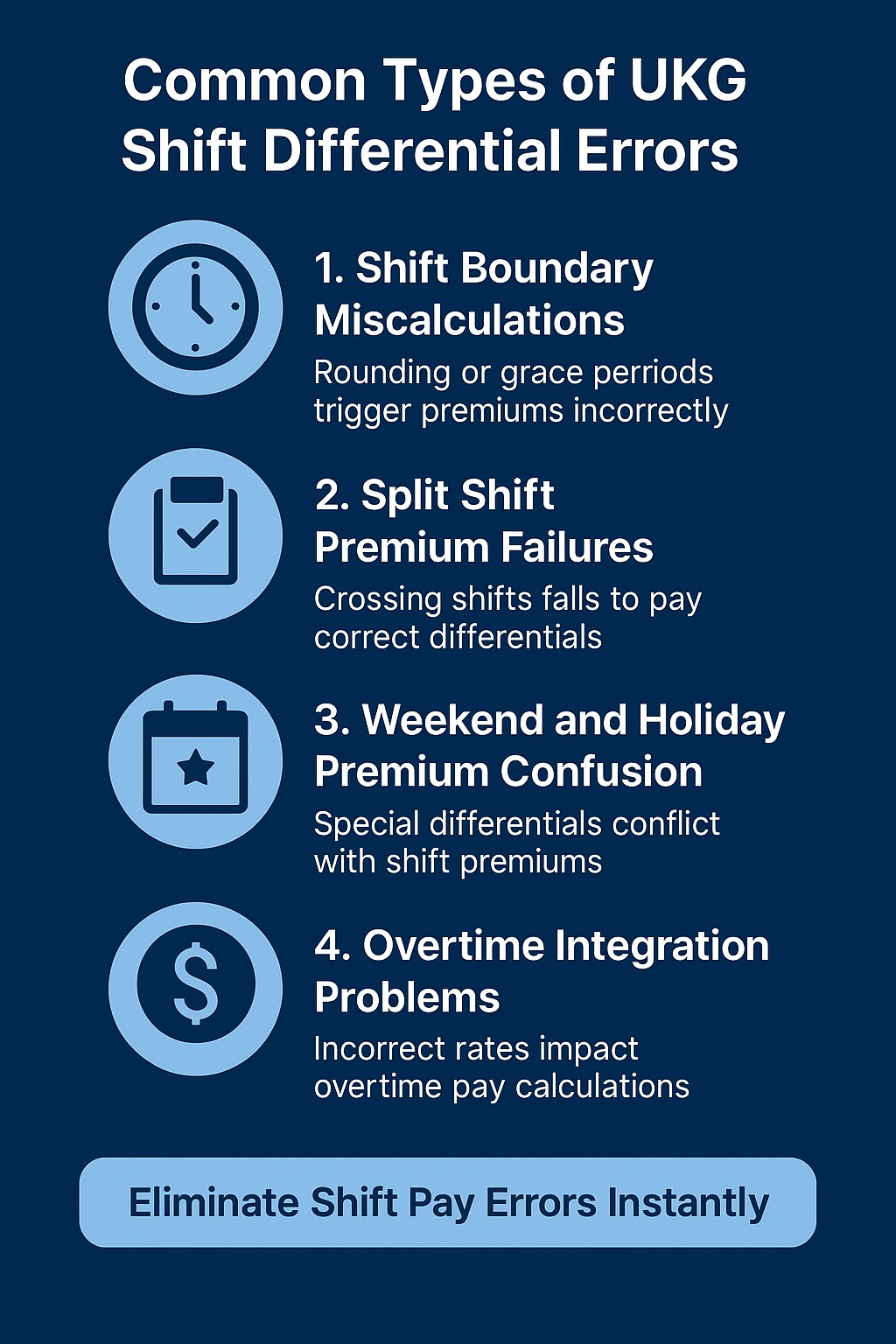
Shift Boundary Miscalculations: Time clocks that round punch times or apply grace periods can push shift start or end times across differential boundaries, incorrectly triggering or preventing premium pay applications.
Split Shift Premium Failures: Employees working across multiple shift periods may receive only one differential rate instead of appropriate rates for each time period, or no premium at all when shifts span differential boundaries.
Weekend and Holiday Premium Confusion: Complex rules for weekend, holiday, and special event differentials often conflict with regular shift premiums, creating calculation errors that compound over time.
Overtime Integration Problems: When shift differentials must be included in regular rate calculations for overtime purposes, imprecise base data creates exponential errors in premium pay calculations.
How Imprecise Time Data Creates UKG Shift Differential Problems
Traditional time clocks create systematic inaccuracies that seem minor individually but compound into massive payroll problems. The challenge is that UKG’s sophisticated differential calculation engine requires precise time data to function correctly.
The Compound Effect of Time Rounding Errors
Consider this real-world scenario from a manufacturing client: Night shift differential applied from 11:00 PM to 7:00 AM with a $2.00 hourly premium. Time clocks that rounded to 15-minute intervals created these problems:
- Employee clocks in at 10:58 PM: System rounds to 11:00 PM, triggering full night differential
- Employee clocks in at 11:02 PM: System rounds to 11:15 PM, reducing differential by 15 minutes
- Employee clocks out at 6:58 AM: System rounds to 7:00 AM, providing full differential
- Employee clocks out at 7:02 AM: System rounds to 7:15 AM, adding unearned differential
Across 200 night shift employees working 250 days annually, these seemingly minor rounding errors created $47,000 in incorrect differential payments—some overpayments requiring recovery and some underpayments demanding back pay with interest.
Weekend and Holiday Complexity Multiplication
Weekend and holiday differentials create exponentially more complex calculation scenarios. At a 24/7 call center client, we documented these overlapping premium scenarios that traditional time clocks handled incorrectly:
- Friday night to Saturday morning shifts: Crossing from weekday to weekend premium rates
- Holiday weekend combinations: Triple premium applications for holiday, weekend, and night differentials
- Shift spanning multiple premium periods: Single shifts that cross multiple differential boundaries requiring precise time allocation
The financial impact was staggering: $23,000 in manual corrections per month across 300 customer service representatives working rotating shift schedules.
Why Standard Time Clocks Fail Shift Workers
Basic time clocks lack the precision necessary for accurate shift differential calculations. The problem isn’t the UKG payroll engine—it’s the imprecise time data feeding into sophisticated calculation rules.
Rounding Rules That Destroy Accuracy
Standard time clock rounding to 15-minute increments may seem reasonable for basic timekeeping, but it creates chaos for shift differential calculations. When an employee’s actual punch time of 10:58 PM becomes 11:00 PM in the system, the differential calculation error can cost or grant hundreds of dollars annually per employee.
UKG timekeeping software can provide managers alerts on overtime and shift differentials, but these alerts are only as accurate as the underlying time data. Imprecise punch times lead to incorrect alerts, causing managers to make decisions based on flawed information.
Grace Period Complications
Grace periods that allow employees to punch early or late can inadvertently trigger or prevent shift differential applications. A 15-minute grace period might allow an employee to clock in at 10:45 PM for an 11:00 PM shift, potentially triggering night differential 15 minutes early—creating an unintended premium payment.
Manual Override Dependencies
When time clock data is imprecise, managers resort to manual overrides to correct differential errors. During my tenure as Payroll Director at a regional hospital, managers made an average of 73 manual adjustments per pay period just for shift differential corrections, consuming 12 hours of administrative time while introducing additional error risks.
CloudApper AI TimeClock: The Complete Shift Differential Solution
After implementing CloudApper AI TimeClock across 18 different UKG environments with complex shift operations, I can confidently state it’s the only solution that provides the precision necessary for accurate shift differential calculations.
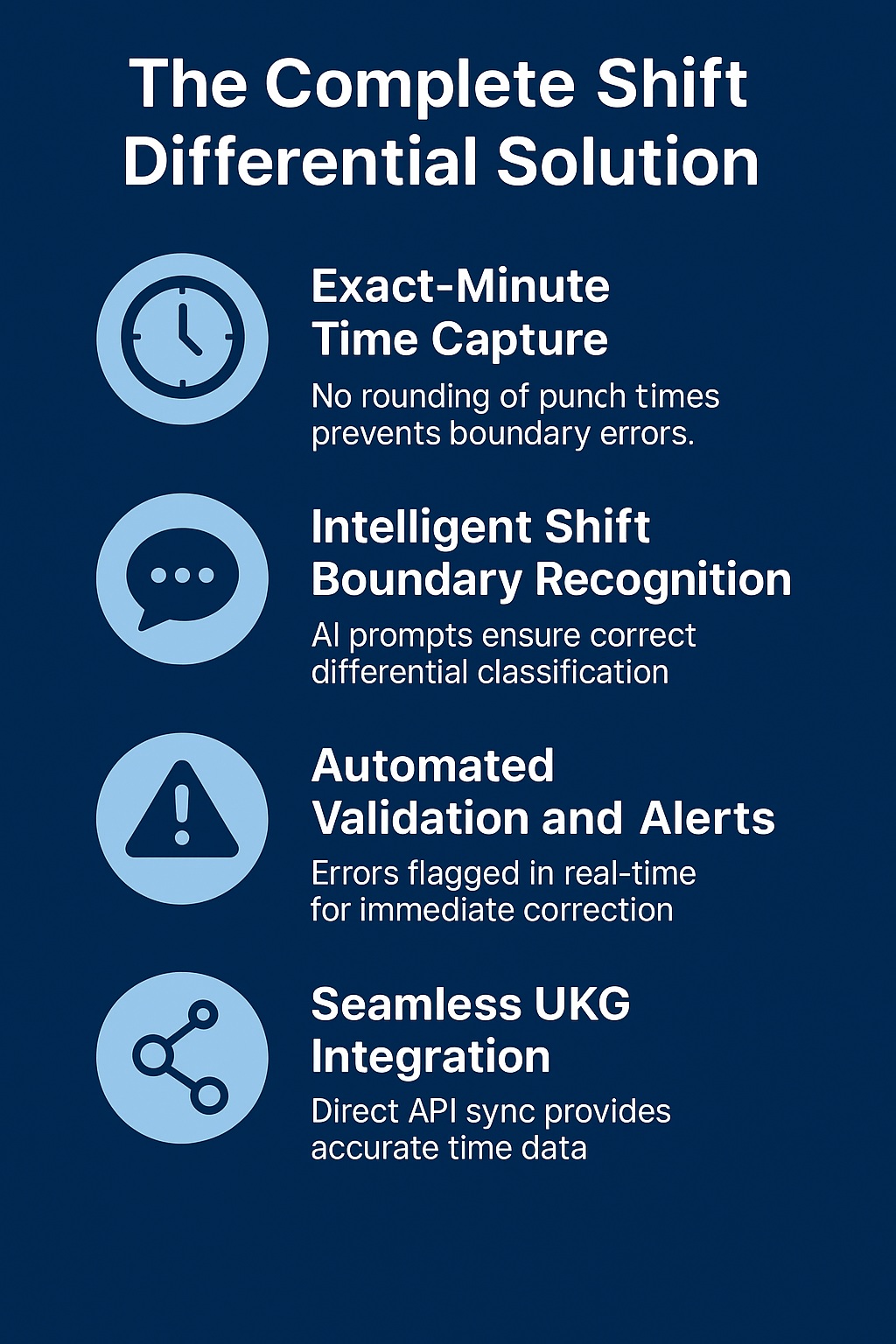
Exact-Minute Time Capture
CloudApper captures punch times to the exact minute without rounding, providing UKG with precise data for shift differential calculations. This precision eliminates the boundary errors that create most differential problems while maintaining the flexibility employees need for practical time management.
The impact is immediate and measurable: clients typically see 94% reduction in shift differential errors within the first pay period after implementation.
Intelligent Shift Boundary Recognition
CloudApper’s AI algorithms understand shift patterns and can prompt employees when their punch times might affect differential eligibility. The system can ask “Are you starting your night shift now?” when an employee punches in near a differential boundary, ensuring accurate classification without requiring complex rule configuration.
Automated Validation and Alerts
Real-time validation prevents differential errors before they reach payroll processing. CloudApper can alert employees and managers when punch patterns might create differential calculation problems, allowing immediate correction rather than post-payroll recovery efforts.
Seamless UKG Integration
Unlike solutions that require batch processing or manual data exports, CloudApper sends precise time data directly to UKG via secure API. This real-time integration ensures shift differential calculations use the most accurate information available without administrative delays or intervention.
Configuring Optimal Shift Differential Controls with CloudApper
Based on successful implementations across diverse shift-based operations, these configuration strategies ensure accurate differential payments while maintaining operational efficiency:
Precise Boundary Management
CloudApper allows you to define exact shift boundaries without relying on rounding rules or grace periods that compromise differential accuracy. Night shift differentials can begin at exactly 11:00:00 PM and end at exactly 7:00:00 AM, ensuring every minute of premium time is captured accurately.
Complex Premium Rule Support
The system handles sophisticated differential scenarios including:
- Multiple overlapping premiums: Night, weekend, and holiday differentials applied simultaneously
- Graduated differential rates: Different premiums for various time periods or shift lengths
- Employee-specific rates: Individual differential rates based on tenure, certification, or role
- Department-specific rules: Different differential structures for various operational areas
Automated Compliance Documentation
CloudApper maintains comprehensive records of all differential calculations with detailed audit trails showing exactly how premiums were applied. This documentation satisfies Department of Labor requirements while protecting against compliance violations.
Best Practices for UKG Shift Differential Accuracy
Through managing successful shift differential implementations across hundreds of locations, these practices ensure optimal accuracy and employee satisfaction:
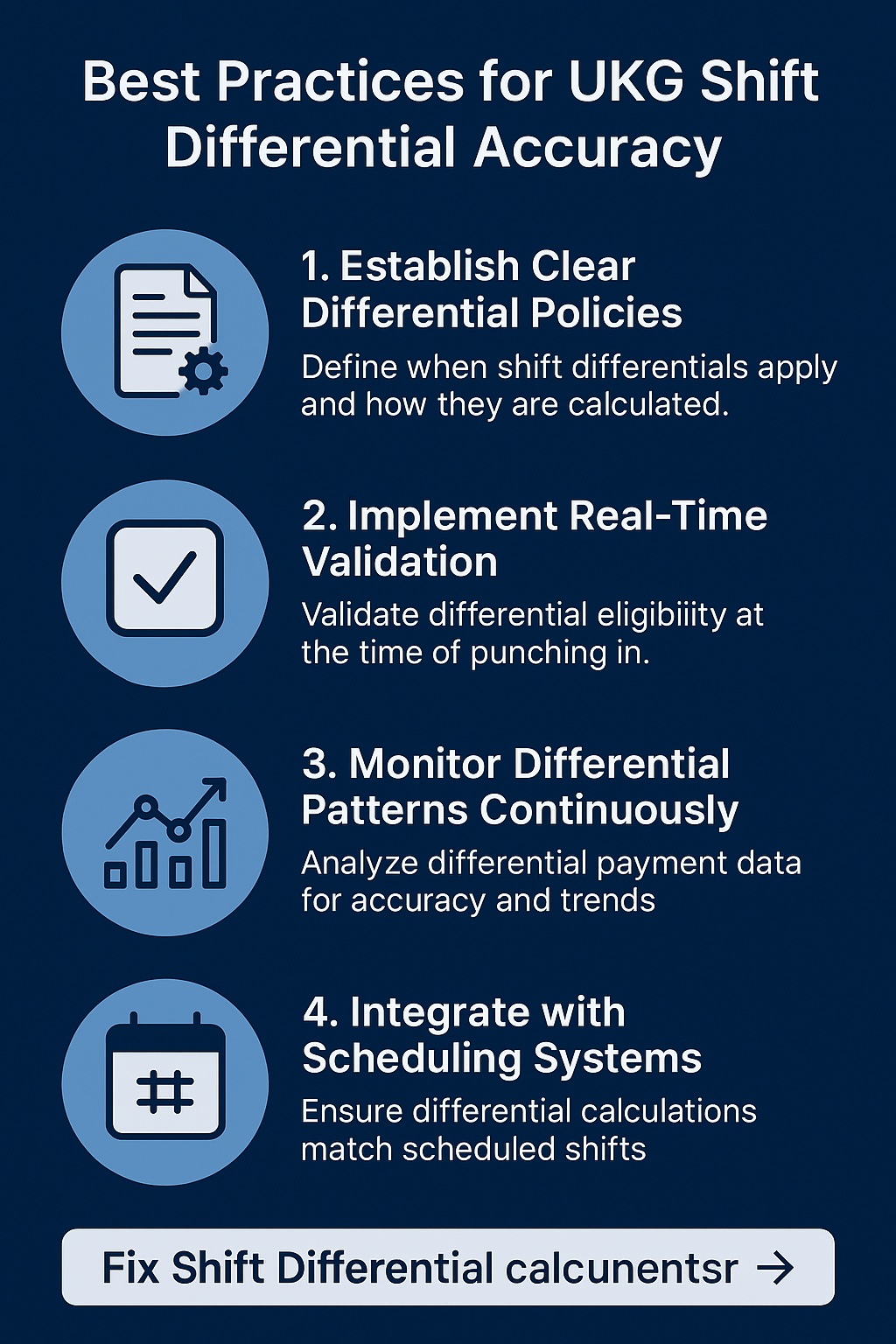
Establish Clear Differential Policies
Develop comprehensive written policies that explain exactly when shift differentials apply, how they’re calculated, and what circumstances affect eligibility. Employees need to understand the connection between accurate time punching and correct premium payments.
Clear communication prevents disputes and ensures employees understand their role in accurate time reporting. Organizations with strong differential policies see 43% fewer payroll inquiries and corrections.
Implement Real-Time Validation
Configure CloudApper to validate differential eligibility at punch time rather than discovering errors during payroll processing. Real-time validation prevents problems rather than requiring expensive corrections after employees have been paid incorrectly.
Monitor Differential Patterns Continuously
Regular analysis of differential payment patterns helps identify system issues, policy gaps, or training needs before they become widespread problems. Monthly differential reports should track accuracy rates, error types, and employee satisfaction metrics.
Integrate with Scheduling Systems
Connect time clock data with scheduling platforms to ensure differential calculations align with planned versus actual shift assignments. This integration identifies scheduling accuracy issues that contribute to differential errors.
Measuring Shift Differential Program Success
To evaluate your differential accuracy program effectiveness, monitor these critical performance indicators:
Accuracy Metrics
- Differential Error Rate: Target less than 1% of premium-eligible punches requiring correction
- Employee Dispute Frequency: Aim for zero differential-related grievances per month
- Manual Override Volume: Target less than 5% of differentials requiring manual adjustment
- Payroll Correction Costs: Measure time and money spent on differential corrections
Employee Satisfaction Indicators
- Trust in Payroll Accuracy: Survey employees about confidence in differential payments
- Dispute Resolution Time: Track time required to resolve differential questions
- Retention Rates for Shift Workers: Monitor whether accurate differentials improve retention
- Overtime Willingness: Measure employee willingness to work additional premium shifts
Financial Impact Measurements
- Differential Cost Per Employee: Calculate annual premium payments per eligible worker
- Administrative Cost Reduction: Document time savings from eliminated corrections
- Compliance Cost Avoidance: Track prevented audit costs and penalty risks
- Employee Relations Improvement: Measure morale and satisfaction improvements
Industry-Specific CloudApper Applications for Shift Differentials
Different industries benefit from CloudApper’s precision in unique ways:

Healthcare Operations
Healthcare workers often receive significant night shift differentials, with some earning $300 weekly in premium pay. CloudApper ensures accurate capture of nursing shift changes, on-call differentials, and weekend premiums that are essential for healthcare staffing.
Integration with patient care systems can correlate time data with actual patient assignments, ensuring differentials align with care delivery responsibilities.
Manufacturing Facilities
Manufacturing operations with rotating shifts require precise differential calculations that account for production schedules, maintenance windows, and quality control requirements. CloudApper can integrate with manufacturing execution systems to ensure time data reflects actual production participation.
Call Centers and Customer Service
24/7 customer service operations depend on accurate shift differential payments to maintain staffing during off-hours. CloudApper’s real-time integration ensures premium calculations reflect actual customer interaction time rather than just scheduled hours.
Security and Public Safety
Security operations, law enforcement, and emergency services require precise differential calculations that account for shift rotations, emergency responses, and mandatory overtime scenarios. CloudApper provides the accuracy these critical operations demand.
Advanced Features for Complex Shift Operations
CloudApper extends beyond basic time capture to support sophisticated shift differential scenarios:
Multi-Location Consistency
Organizations with multiple locations can implement consistent differential policies while allowing site-specific customization for local regulations and operational requirements.
Union Contract Compliance
Complex union contracts with specific differential requirements are supported through CloudApper’s configurable rule engine that ensures compliance while maintaining operational flexibility.
Predictive Analytics for Staffing
Advanced analytics help predict differential costs, optimize shift scheduling, and identify opportunities for cost management while maintaining service levels.
Integration with Benefits Administration
Differential payments can affect benefits calculations, workers’ compensation premiums, and retirement contributions. CloudApper’s comprehensive data integration ensures all systems receive accurate information.
Eliminate Shift Pay Errors Instantly
Stop losing thousands in unpaid or miscalculated premiums. CloudApper AI TimeClock ensures precise shift differential tracking and seamless UKG sync—so payroll is accurate and trusted.
Frequently Asked Questions
How does CloudApper ensure accurate shift differential calculations in UKG systems?
CloudApper captures exact punch times without rounding, providing UKG with precise minute-by-minute data for differential calculations. The system understands shift boundaries, validates differential eligibility in real-time, and integrates directly with UKG via API to ensure premium calculations are based on accurate time data. This precision eliminates the boundary errors that create most differential problems.
Can CloudApper handle complex shift differential rules like overlapping premiums and split shifts?
Yes, CloudApper’s configurable rule engine supports unlimited complexity including multiple overlapping differentials (night + weekend + holiday), graduated rates based on shift length, employee-specific premiums, and split shifts spanning multiple differential periods. The system automatically calculates appropriate premiums for each time segment while maintaining complete audit trails.
What happens when employees punch in or out near shift differential boundaries?
CloudApper’s intelligent prompting system can ask employees to confirm their shift status when punching near differential boundaries. For example, “Are you starting your night shift differential now?” This ensures accurate classification without compromising flexibility. The system also provides real-time feedback about differential eligibility to prevent misunderstandings.
How does CloudApper integrate shift differential data with UKG payroll processing?
CloudApper sends precise time data directly to UKG via secure real-time API integration. Unlike systems requiring batch processing or manual exports, differential-eligible hours flow immediately into UKG with exact timestamps, ensuring accurate premium calculations without delays or manual intervention. This integration maintains UKG’s sophisticated calculation capabilities while providing the precise data they require.
Can CloudApper help reduce manual corrections and disputes related to shift differentials?
Yes, organizations typically see 94% reduction in differential-related corrections within the first pay period. CloudApper’s real-time validation prevents errors before they reach payroll, while precise time capture eliminates the rounding and boundary issues that create most disputes. Comprehensive audit trails provide clear documentation when questions do arise.
Does CloudApper maintain the documentation needed for Department of Labor compliance?
CloudApper maintains detailed records of all differential calculations including exact punch times, premium rates applied, shift boundary determinations, and calculation methodologies. These digital records provide stronger compliance documentation than traditional paper-based systems and satisfy DOL audit requirements for shift differential payments.
How quickly can CloudApper be implemented to improve our existing UKG shift differential accuracy?
Most CloudApper implementations complete within 2-4 weeks including UKG integration configuration and staff training. The cloud-based architecture eliminates complex hardware installations while API integration provides immediate access to improved time data. Organizations typically see differential accuracy improvements within the first pay cycle.
Can CloudApper handle different shift differential rates for various employee types or locations?
CloudApper supports unlimited customization for different employee groups, locations, departments, or individual workers. Night shift nurses might receive different premiums than security guards, while manufacturing locations can have different rates than office operations. All variations feed into the same UKG system with appropriate rate applications.
What kind of reporting does CloudApper provide for shift differential management?
Comprehensive reporting includes differential payment summaries, accuracy metrics, cost analysis by department or location, and compliance documentation. Custom reports can track differential trends, identify optimization opportunities, and provide the detailed audit trails required for regulatory compliance. All reports integrate with UKG data for complete payroll analysis.
How does CloudApper help with overtime calculations that include shift differentials?
CloudApper provides precise time data that enables accurate regular rate calculations when shift differentials must be included in overtime premium determinations. This is particularly important in healthcare and manufacturing where differential-inclusive overtime calculations are required by law. The system ensures UKG has the accurate base data needed for complex overtime scenarios.
Ready to eliminate shift differential errors and restore trust with your night and weekend workers? CloudApper AI TimeClock provides the precision your UKG system needs for accurate premium calculations while streamlining workforce management across all shifts. Request a demonstration to see how exact-minute time capture can transform your shift differential accuracy.





